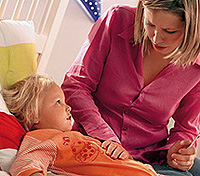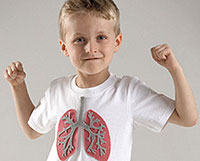How to figure out among modern poliomyelitis vaccines? What vaccine to choose for a child? Answers to these questions you will find in the article.
Content
Graft from polio
Considering that poliomyelitis - viral infection and specific therapy affecting these viruses, no, the only effective means of preventing the disease is the vaccination.
Two drugs are used for vaccination against poliomyelitis: oral (from lat. ORIS mouth, referring to the mouth) Live polio vaccine (OPV) containing weakened alive polio viruses, a solution of which dripped into the mouth, and an inactivated polio vaccine (IPD) containing killed wild polio viruses, which is introduced by injection.
Both vaccines contain 3 types of poliomyelitis virus. That is, protect against all existing «Variations» of this infection. True, inactivated polio vaccine until in our country do not produce. But there is a foreign vaccine interval polyo that can be used for vaccination. In addition, they are part of the tetrakki vaccine (combined vaccine for diphtheria prevention, tetanus, cough, poliomyelitis). Both of these drugs are used on commercial conditions at the request of parents.
Vaccines against poliomyelitis can be administered simultaneously with immunoglobulin and any other vaccines, with the exception of BCG.
Oral polio vaccine
Pink liquid substance, bitter-salty taste.
Introduction Method: Installing in the mouth, kids - on the lymphoid fabric of the pharynx, older children - to the surface of the sky almonds, where immunity begins to form. In these places there are no taste nipples, and the child will not feel the unpleasant taste of vaccine. Otherwise, abundant salivation will arise, the baby will swallow the drug, it will fall with saliva in the stomach and collapses there. The vaccination will be inefficient. Oral polio vaccine Install from a disposable plastic dropper or with a disposable syringe (without a needle).
The dose depends on the concentration of the drug: 4 drops or 2 drops. If the baby knocked down after receiving the vaccine, the procedure repeat. After rejugging the vaccine is no longer administered, and the next dose is given in a month and a half. Within an hour after the introduction you can not feed and drink a child.
 Immunization scheme: The first three vaccination calendar vaccinations are carried out in 3, 4, 5 and 6 months, followed by revaccination once in 18, 20 months. and in 14 years. It is believed that only 5 administrations of polio living vaccine fully guarantee the absence of diseases by paralytic poliomyelitis when meeting with infection. If, in immunization, the vaccine graph is disturbed, and the intervals between the introductions of the vaccine turned out to be longer, then it is not necessary to reinstall the child, it is not necessary to continue the introduction of all missing vaccinations.
Immunization scheme: The first three vaccination calendar vaccinations are carried out in 3, 4, 5 and 6 months, followed by revaccination once in 18, 20 months. and in 14 years. It is believed that only 5 administrations of polio living vaccine fully guarantee the absence of diseases by paralytic poliomyelitis when meeting with infection. If, in immunization, the vaccine graph is disturbed, and the intervals between the introductions of the vaccine turned out to be longer, then it is not necessary to reinstall the child, it is not necessary to continue the introduction of all missing vaccinations.
Body reaction. After the introduction of vaccinations from polio vaccination reactions (local or general), as a rule, are absent. In extremely rare cases, the appearance of a subfebrile temperature is possible (up to 37.5 degrees C) 5-14 days after vaccination. In early age children occasionally observed the participation of the chair, which is preserved within 1-2 days after vaccination and passes without treatment. These reactions are not complications. If the violations of the chair are pronounced (there is mucus, greens, blood streaks, etc.) and for a long time, it can be a manifestation of an intestinal infection, which in time accidentally coincided with vaccination.
How «working» graft. Oral live polio vaccine for a long time (up to 1 month) persists in the intestine and, like all living vaccines, the immunity forms in the body of a grafted person, almost identical to the one that occurs after the infection itself. At the same time, antibodies (protective proteins) in the blood and on the intestinal mucosa (so-called, secretory immunity) are synthesized «Dick» virus penetrate the body. In addition, specific protective cells are formed, which can be recognized in the body of polio viruses and destroy them. IMPORTANT AND OTHER PROFESSION: While the vaccine virus lives in the intestine, it does not allow it there «wild» Polio virus. Therefore, in the regions where there is poliomyelitis, newborn children right in the maternity hospital put a live vaccine to protect the crumb in the first month of life from infection. Long immunity this vaccination does not forms, so it is called «null». And the first vaccinating dose of the child is introduced in 2 months and continue to vaccinate it in full scheme.
The living vaccine against polio has another unexpected property – It stimulates the synthesis of interferon synthesis in the body (antiviral substance). Therefore, indirectly such a vaccination can protect against influenza and other viral respiratory infections.
Inactivated polio vaccine
Available in liquid form, packaged in a syringe dose of 0.5 ml.
Method of administration: injection. Kids up to 18 months. - subcutaneously into the sublock region (possibly in the shoulder) or intramuscularly in the thigh, older children - in the shoulder. No restrictions on food and drink time required.
Immunization scheme. The primary vaccination course is 2 or 3 injection vaccines with an interval of 1.5-2 months. Immunity is created after 2 administrations, but in some cases it is preferable to introduce a vaccine three times. This is especially important for children with reduced immunity, which requires large doses or high multiplicity of drug administration to form a resistant immune response. There are in mind kids with chronic diseases, immunodeficiency states, as well as those who have undergone an operation to remove the spleen.
 After 1 year after the third introduction, the first revaccination is carried out. The second is provided in 5 years, more revaccinations are not required.
After 1 year after the third introduction, the first revaccination is carried out. The second is provided in 5 years, more revaccinations are not required.
Body reaction. After administration, 5-7% of the grafts may have local vaccine reactions (which is not complicing the vaccination) in the form of edema and redness not exceeding 8 cm in diameter. In 1-4% of cases, general vaccine reactions are noted in the form of a short-term low rise temperature, child's concern in the first day after vaccination.
How «working» graft. The introduction of an inactivated polio vaccine in a graft person is produced by blood antibodies. However, on the intestinal mucosa, they practically do not form. Protective cells that can recognize and destroy polio viruses in the body are not synthesized together with the causative agent, as it happens when vaccinated. It is an essential minus vaccinations.
However, when using an inactivated vaccine, there is never vaccinated poliomyelitis and it can be safely introduced to children with immunodeficiency.
Complications. The side effect of the IPM can be in very rare cases, allergic rash.
It is important to know unvacitated!
People who have no vaccinations from poliomyelitis (regardless of age), which are suffering from immunodeficiency, can be infected with a graft child and get sick with vaccine-associated polio (VAP).
There are cases when parents suffered from graft children, patients with AIDS, in the immunodeficiency stage, as well as relatives with primary immunodeficiency or those who receive medicines, overwhelming the immune system (in the treatment of oncological diseases). To prevent such child situations, it is recommended to vaculate inactivated polio vaccine, as well as wash your hands after the baby washed and not kiss the lip.
Vaccination against poliomyelitis, like any other vaccination, if it is made on time and by the rules, will help the fragile crumb to confront a severe and dangerous disease. So, will make a child stronger, will strengthen his body and relieve parents from many problems and tests that you usually have to worry about the family seriously sick babe.









